Courtesy: Sri.S.Ramaswamy



Puja Preparation
Women wake early on this day to create elaborate 'kolam' on the grounds in front of their doorway or home. Kolam is created with colored rice flour placed on the ground carefully by using one's hand. The women take several hours to finish the kolum. On this day the new rice is collected and cooked in pots until they over flow. It is this overflowing which means Pongal. This overflowing of rice is a joyous occasion, and the children and adults as well will shout out 'Pongal-o-Pongal!'

Surya Pongal Puja Process
The Sun God is offered boiled milk and jaggery. A plank is placed on the ground, a large image of the Sun God is sketched on it and Kolam designs are drawn around it. In the centre of the plank is drawn a large figure of the Sun God with his effulgent rays. The "Puja" of the Sun God starts after the auspicious moment of the birth of the new month Thai. Prayers are rendered to the Sun God to seek his benedictions.
The Sun God is given pride of place during Pongal. In the villages, people gather in the courtyard and prepare the Pongal in the open. The pot in which the Pongal is cooked is decorated with flowers, sugarcane pieces, turmeric plant etc. The first offering is made to the Sun.

Surya Pongal Delicacies
The rice is cooked and prepared as a dish called Pongal, which is rice with dhal and sugar. This Pongal variety is called venpongal, ven meaning white. Another variety is also prepared with dhal and jaggery (sweet), called chakra pongal, chakrai meaning sweet. To accompany the venpongal, people eat brinjal (eggplant) sambar (stew), vadai, idli and spicy accompaniments.
Sweets, puddings, cooked rice or 'Sarkarai Pongal' are prepared on this day. On all the three days of Bhogi, Pongal and Maattu Pongal, women adorn the entrance of their houses with colorful kolams. Large patterns, decorated with colorful flowers and powders are drawn, crowding the entire street.
In earlier days Thai Pongal is prepared in a hand made pot which is decorated fully with turmeric, kumkum andsunnaambu. we need to tie turmeric plant with leaves and turmeric around the pot. Nowadays we are preparing pongalin cooker and hence we need to decorate the pressure cooker accordingly. While we get the whistles, we need to tell "Pongalo Pongal" and pray to god.
*If you really need more sweet in pongal, increase the jaggery.
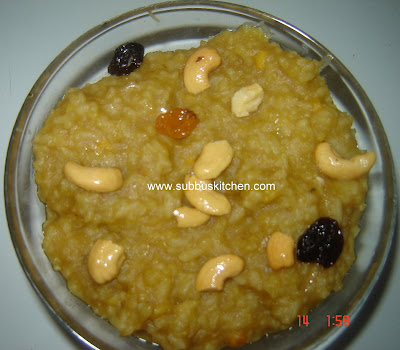
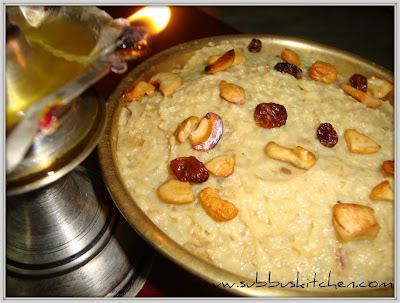
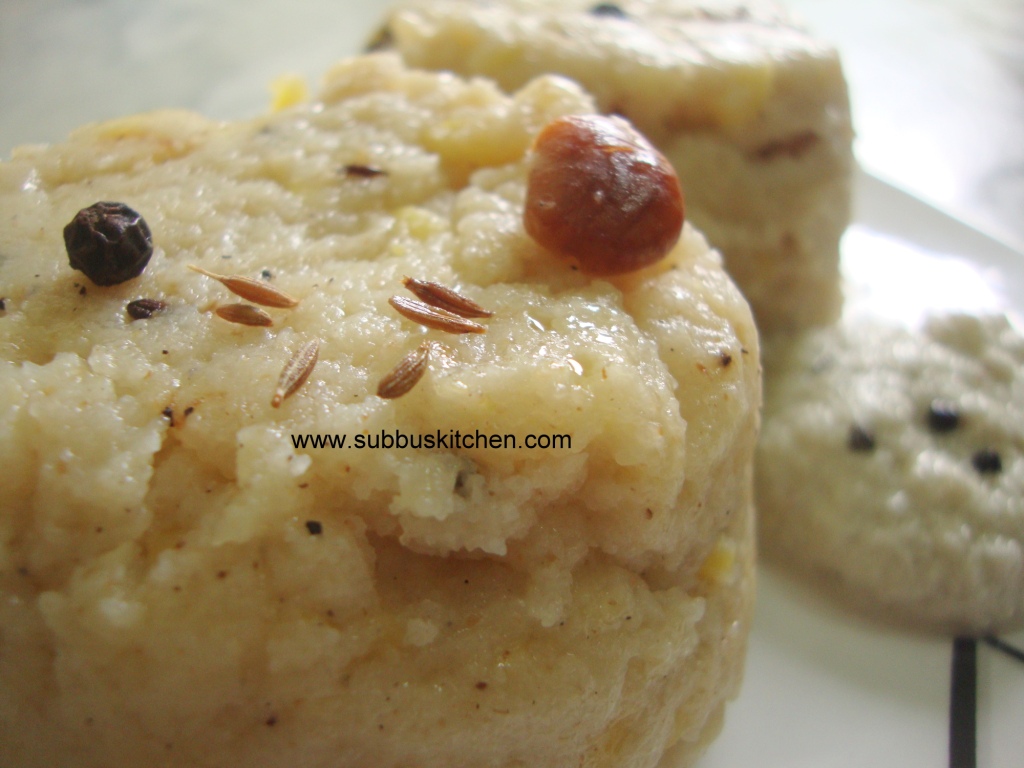
Ingredients:
Method:

தை பொங்கல் பானை வைக்க நேரம்::7-45 AM
The second day of Pongal is known as 'Surya Pongal' and is dedicated to the Sun God. It is the day on which the celebration actually begins and is also the first day of the Tamil month Thai. On this day the granaries are full, the sun shines brightly, trees are in full bloom, bird-songs resound in the air and hearts overflow with happiness that get translated into colorful and joyous celebrations.
Puja Preparation
Women wake early on this day to create elaborate 'kolam' on the grounds in front of their doorway or home. Kolam is created with colored rice flour placed on the ground carefully by using one's hand. The women take several hours to finish the kolum. On this day the new rice is collected and cooked in pots until they over flow. It is this overflowing which means Pongal. This overflowing of rice is a joyous occasion, and the children and adults as well will shout out 'Pongal-o-Pongal!'
Surya Pongal Puja Process
The Sun God is offered boiled milk and jaggery. A plank is placed on the ground, a large image of the Sun God is sketched on it and Kolam designs are drawn around it. In the centre of the plank is drawn a large figure of the Sun God with his effulgent rays. The "Puja" of the Sun God starts after the auspicious moment of the birth of the new month Thai. Prayers are rendered to the Sun God to seek his benedictions.
The Sun God is given pride of place during Pongal. In the villages, people gather in the courtyard and prepare the Pongal in the open. The pot in which the Pongal is cooked is decorated with flowers, sugarcane pieces, turmeric plant etc. The first offering is made to the Sun.
Surya Pongal Delicacies
The rice is cooked and prepared as a dish called Pongal, which is rice with dhal and sugar. This Pongal variety is called venpongal, ven meaning white. Another variety is also prepared with dhal and jaggery (sweet), called chakra pongal, chakrai meaning sweet. To accompany the venpongal, people eat brinjal (eggplant) sambar (stew), vadai, idli and spicy accompaniments.
Sweets, puddings, cooked rice or 'Sarkarai Pongal' are prepared on this day. On all the three days of Bhogi, Pongal and Maattu Pongal, women adorn the entrance of their houses with colorful kolams. Large patterns, decorated with colorful flowers and powders are drawn, crowding the entire street.
Pongal festival is a harvest festival celebrated by the people of TamilNadu at the end of harvest season. It coincides with the festival Makara Sankranthi celebrated throughout India as the winter harvest. The word pongal itself refers to the "boiling over" of milk and rice during the month of Thai. Farmers work for the whole year harvesting the paddy crops and using the freshly produced rice, farmers will prepare pongal on this auspicious day and show their gratitude to Lord Surya. On this festival day, the sun god(Suriyan) will turn from southern direction to northern direction. It is a tradition for tamilians to decorate their homes with banana and mango leaves and embellish the floor with decorative patterns drawn using rice flour.
Pongal Festival is a 3 day festival which starts from the last day of the tamil calender month Margazhi and proceed till the second day of the Tamil Calender month Thai. The first day of the festival is called Bogi followed by Thai Pongal and ends with Kanu Pongal.
 |  | 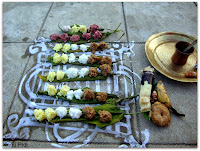 |
| Bhogi | Thai Pongal | Kanu Pongal |
In earlier days Thai Pongal is prepared in a hand made pot which is decorated fully with turmeric, kumkum andsunnaambu. we need to tie turmeric plant with leaves and turmeric around the pot. Nowadays we are preparing pongalin cooker and hence we need to decorate the pressure cooker accordingly. While we get the whistles, we need to tell "Pongalo Pongal" and pray to god.
We need to prepare the sakkarai pongal, vadai, plain rice for neivedhyam and we need to do the neivedhyam only at the time when "Thai" months begins.
We have use flat beans, pumpkin, sakaraivellikizhangu, senaikizhangu, raw banana vegetables on this occasion.
In a open place, where we get good sun rays, we need to clean the place and put kolam and inside the kolam we need to draw sun and moon symbols and we need to perform poojas for vinayakar and suriyan and we need to keep sugarcane, sakaraipongal, beetle leaves with seeds, banana and other dishes for neivedhyam and we need to pray to god for good prosperty in life.
Wish you a very happy Pongal.!
Sweet Rice Pongal / Sakkarai Pongal is an auspicious neivedhyam dish for many festivals. Even in many temples Sweet Rice Pongal / Sakkarai Pongal is given as Prasadham. For most of the festivals dedicated to Lord Vishnu we prepare this wonderful dish as neivedhyam. It is one of the easiest sweet recipe that we can make with less effort
 |
| Sweet Rice Pongal / Sakkarai Pongal |
| Servings | 4 |
| Preparation Time | - |
| Cooking Time | 20 mins |
Ingredients :
| Raw Rice | 1/2 Cup |
| Moong dal | 3 tablespoon |
| Jaggery* | 3/4 Cup |
| Cardamom Powder | 1/4 teaspoon |
| Cashews | 5-6 |
| Pachai karpooram | a pinch |
| Raisins | 5-6 |
| Ghee | 4 tablespoons |
| Water | 2 1/2 Cup |
*If you really need more sweet in pongal, increase the jaggery.
Method:
- Heat a pan and add 1/2 teaspoon of ghee and roast the moong dal till they turn golden brown color
- Wash the raw rice twice or thrice and add water and roasted moong dal and pressure cook the raw rice along with the moongdhal in the pressure cooker and cook for 4 whistles.
- After the rice is cooked, remove from cooker and mash it nicely and keep it aside
- Heat the pan and keep the flame in medium and add broken cashews and raisins and fry them till the cashews turns golden brown color. Remove the fried cashews and raisins from flame and keep it aside
- In the pan, add jaggery and pour little water just to soak the jaggery . When the jaggery gets dissolved add the mashed cooked rice with dal and mix well
- Mix the rice using a spatula to spread the jaggery evenly by keeping the flame low.
- Add the ghee slowly and keep on stirring the sakkarai pongal for atleast 4-5 mins ( you can notice the ghee in the pongal leaves the side of the vessel).
- Finally add the fried cashews, powdered elachi, Karpooram powder and dried grapes.
- Now the sweet Rice pongal is ready to serve hot as well as for neyveidhyam.
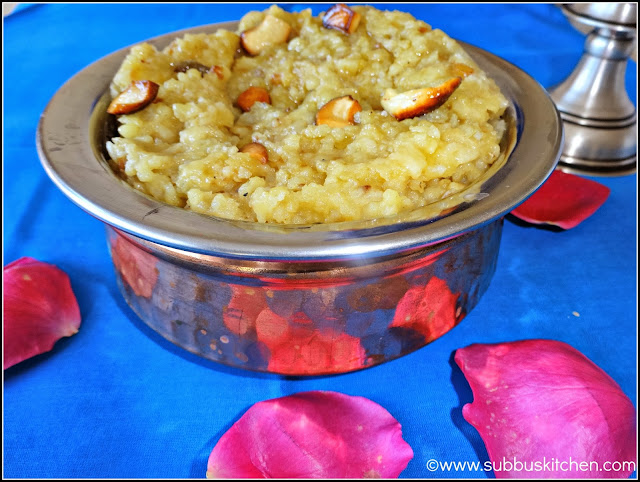 |
| Sweet Rice Pongal / Sakkarai Pongal |
Akkara Adisil is a famous Iyengar recipe. Akkara Adisil is usually prepared on the "Koodaravalli day" which comes on 27th day of the Margazhi month and offered to the lord. Akkara Adisil usually offered as a prasadham in the temples which has an unique taste.

Ingredients
| Raw Rice | 3/4 cup |
| Milk | 4 cups |
| Jaggery | 1 ¼ Cup |
| Moong Dal | ¼ Cup |
| Ghee | 2 tablespoon |
| Cashew Nuts | 10 |
| Dried Grapes | 10 |
| Cardamom powder | 1 teaspoon |
Method:
- In a heavy bottomed pan, Rinse the rice and dry fry the rice moong dal till it turns golden red color
- Add fried moong dal and rice and 4 cups of milk in a vessel and pressure cook it. Leave atleast 7-8 whistles so that the rice is mashed well.
- Add the grated jaggery and little water in another pan and keep it in flame for a while till the jaggery dissolves and the raw smell of jaggery goes off.
- Add this jaggery juice to the cooked and mashed rice and mix it well and keep the flame low
- In a separate pan, add ghee and add broken cashew nuts, dried grapes and fry it till it turns golden brown color. Add these fried nuts to the Akkara Adisil
- Finally add cardamom powder and mix it well
- The yummy akkara adisil is ready for neivedhyam for Kudaravalli and Pongal and also for serving
The conventional Akkara Adisil should be prepared in the large vessel with the slow heat, but to save time I gave the recipe in the pressure cooker.
Venn Pongal is a traditional SouthIndian breakfast dish. I love to do VenPongal as it is very easy and quick. We should be generous in using ghee for Pongal. The flavour of ghee with pepper is the unique taste of pongal. It is the traditional neivedhyam in any temple. The shine and smell of ghee in pongal will tempt everyone to have more.
Ingredients:
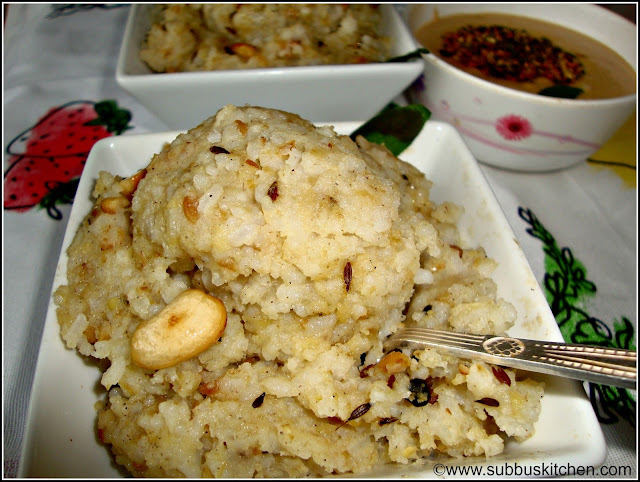 |
| VennPongal(VenPongal) |
| Preparation Time | 10 mins |
| Cooking Time (Cumin Seeds) | 20 mins |
| Servings | 4 |
Ingredients:
| Raw Rice | 3/4 Cup |
| Jeera (Cumin Seeds) | 1 teaspoon |
| Moong dal | 1/4 cup |
| Salt | To taste |
| Cashew Nuts | 10 |
| Ghee/Oil | 3 tablespoon |
| Whole black pepper | 1 teaspoon |
| Pepper Powder | 1 teaspoon |
Method:
- Heat a heavy bottomed pan, add moong dal
- Roast the moongdhal in the dry pan till it turns golden brown color
- Add the fried moongdal with the raw rice for rinsing.
- Cook the raw rice along with the moongdhal and salt in the pressure cooker by adding 1/2 up extra water than normal rice cooking and for 2 extra wistles in the cooker than normal. This will make the rice smashed.
- Heat the pan, add 1 teaspoon on ghee and add the broken cashews and fry till they turn golden brown color. Take this out and keep it aside in a plate.
- In the pan, pour the remaining ghee and add the cumin seeds. Once the cumin seeds begins to sputter add the whole black pepper and pepper powder. Fry for some seconds.
- Add the smashed cooked rice with dhal and add the fried cashews. Stir the rice evenly to spread the pepper and salt and swtich off the flame.
- Now the Venn pongal is ready to serve hot. You can serve this with coconut chutney/sambar
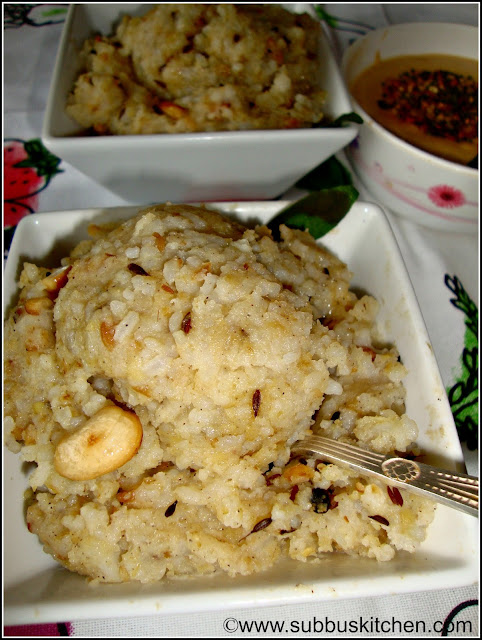 |
| VennPongal(VenPongal) |

| Preparation Time | 15 mins |
| Cooking Time | 30 mins |
| Servings | 3 |
Ingredients:
| Rawa | 1 Cup |
| Moong Dal | 1/2 cup |
| Water | 4 cups |
| Ghee | 2 Tablespoon |
| Whole Black Pepper | 3 Teaspoon |
| Cumin Seeds | 1 Teaspoon |
| Cashew Nuts | 10 - 15 |
| Salt | To Taste |
| Curry Leaves | 1 Handful |
Method:
- Dry fry the moong dal in a heavy bottomed pan till it turns golden red colour.
- Add 1:3 (for 1/2 cup dal, you need to add one and half cup of water) water in the pressure cooker and cook the dal. For proper cooking, you may need to cook this in simmer and allow three whistles. Once its cooked, smash it with a ladle and keep it aside.
- In the pan, add some ghee and the rawa and fry it till it turns to golden red color and take it out and keep it aside
- Add 2 cups of water (1 cup of rawa = 2 cups of water) in the cooked dal and bring the water to boil. Also add the salt
- Once the water starts to boil, add the rawa slowly in the water, while you continue to stir the water to avoid the lumps. Keep the flame in simmer and stir it till water is absorbed
- Add three tables spoon of oil and add the black pepper, cumin seeds, cashew. Allow the pepper to completely fry in the ghee. The pepper has to float on the top of the ghee from bottom once its cooked. Add the curry leaves and fry for a while.
- Mix the ghee mixture to the cooked rawa pongal and mix well.
- The yummy rawa pongal is ready to serve with coconut chutney.
Ulundhu vadai is a great and tasty appetaizer. Also, we make this vadai for most of the festivals for neyvedhyam.

| Preparation Time | 5 mins |
| Cooking Time | 15 mins |
| Yield | 15 |
Ingredients:
Ulundhu(Urdhal) - 1 Cup
Green Chilli - 2
Ginger - 1 teaspoon
Salt - To Taste
Rice - 2 teaspoon
Oil - for Frying
Curry leaves - few
Method:
- Soak the Ulundhu(Urdhal) and rice in water for 45 mins. For softer vadai, we can soak it for 2-3 hours
- Strain it and grind it along with green chilli and salt in a grinder by adding 1 handfull of water. Grind it till the urdhal is smooth without any bumps
- Sprinkle water only if necessary.
- Take it from grinder after the urdhal is ground properly. If you take the flour in your wet hands, it should roll like a ball. If we drop a pinch of dough in water, it should float it in water. If the dough gets sinked, then we need to grind it more. This is the right stage to remove from the grinder.
- Add the finely chopped ginger,curry leaves and mix well
- Now Heat the oil in pan and once the oil is hot, add a little amount of flour to check for the readiness of oil. If the flour comes up right way, then the oil is ready
- In a banana leaf or small plastic cover, add little amount of urdhal flour and make small hole in the middle and spread the flour and then take it from leaf using water and add it to the pan. I normally wet my palm and add small ball of dough, pat it and make a small hole in center and drop it in oil.
- Add 4-5 urdhal flour and add it to oil. Slowly change the vadai to other side to cook properly in both sides
- Once the vadai becomes golden brown color, remove from flame
- The yummy Urdhal vadai(Medhuvadai) is ready to serve / ready for neyvedhyam. For neyvedhyam we dont add onion.
Note:
For making this vadai on a normal day, we can add finely chopped onions with the dough and make scrumptious vadas.
Ingredients for Grinding:
Bogi & Pongal Festival Special Lunch Menu
Pongal Kootu / Kadamba kootu is one of the important festival sambar. Mainly prepared on Pongal Festival. We can call this as Kanu Kootu. We have to prepare this on Pongal and we can keep one ladle of kadamba sambar separately for Kanu festival. Here we are using mixed vegetables and so the flavour is excellent. Lets go the recipe now...
 |
| Kadamba Kootu / Pongal Kootu |
| Servings | 4 |
| Preparation Time | 10 mins |
| Cooking Time | 30 mins |
 |
| Kadamba Kootu / Pongal Kootu |
Ingredients for Sambar:
| Tamarind | 1 small lemon size |
| Thur dal | 1/2 Cup* |
| Salt | To Taste |
| Sweet Potato | 1 |
| Raw Banana | 1 |
| Potato | 1 |
| Pumpkin | 100 grams |
| Ash Gourd | 100 grams |
| Mochai (Lima Beans) | 1/4 cup |
| Broad Beans(Avarakkai) | 10 |
* My one full cup is 250 ml capacity
Ingredients for Grinding:
| Red Chilli | 8 |
| Channa dal(Bengal Gram) | 1 tablespoon |
| Coriander Seeds | 2 tablespoon |
| Grated Coconut | 1/2 Cup |
| Fenugreek seeds | 1/2 teaspoon |
| Oil | 1 teaspoon |
Ingredients for Seasoning:
| Oil | 2 teaspoon |
| Mustard Seeds | 1 teaspoon |
| Hing | a Pinch |
| Red Chillies | 1 |
| Curry Leaves | Few |
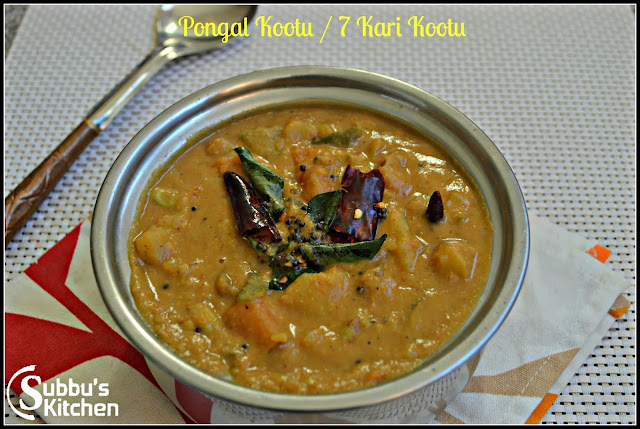 |
| Kadamba Kootu / Pongal Kootu |
As all of us know Pongal is a special occasion and every one wanted to make sure that the lunch menu on Pongal day a grand and great. The intention of this post is to share the lunch menu that we follow which I believe makes your Pongal a grand. In the souther part of the tamilnadu, the brahmin's give more importance to the Pongal than the Bogi. Accordingly their lunch menu will also vary. I found that in Chennai the northern part of Tamil nadu, bogi is given more importance than the Pongal. The below menu is the one that we follow and this varies from family to family. Happy Pongal.!!
Bogi & Pongal Festival Special Lunch Menu
| Pongal Fesival | Bogi Festival | |||||
| Sweet |
|
| ||||
| Kuzhambu |
|
| ||||
| Pachadi |
|
| ||||
| Poriyal |
|
| ||||
| Koottu |
|
| ||||
| Rasam |
|
| ||||
| Payasam |
|
| ||||
| Vadai |
|
| ||||
| Pickle |
|
| ||||
| Appalam | Fried Appalam | Fried Pappodam | ||||
| Curd | Curd | Curd |
 |  |
| Medhu Vadai | Pongal Kootu |


















































No comments:
Post a Comment